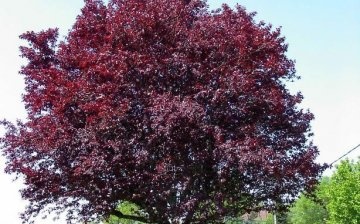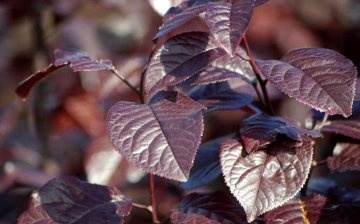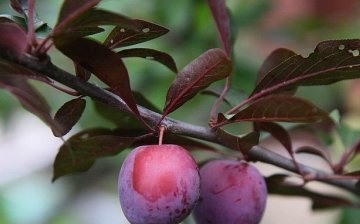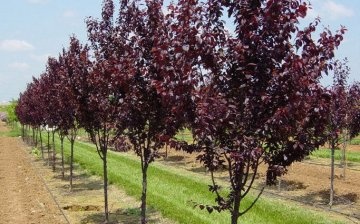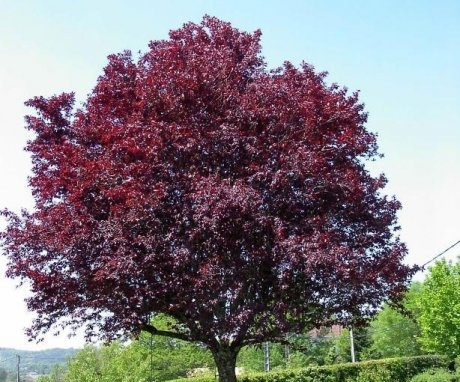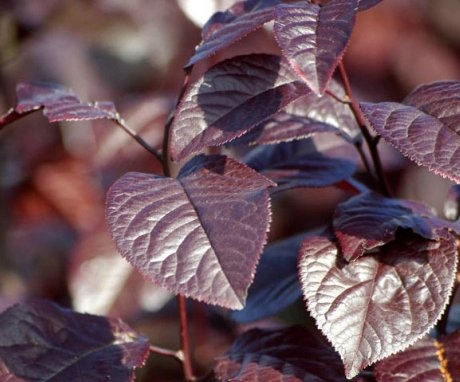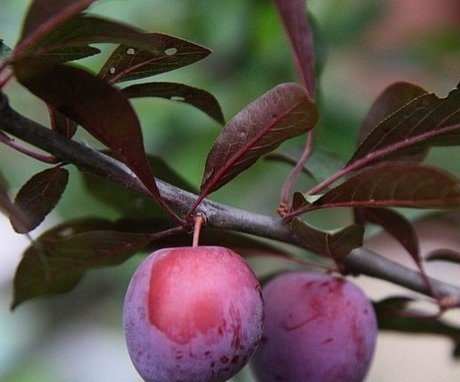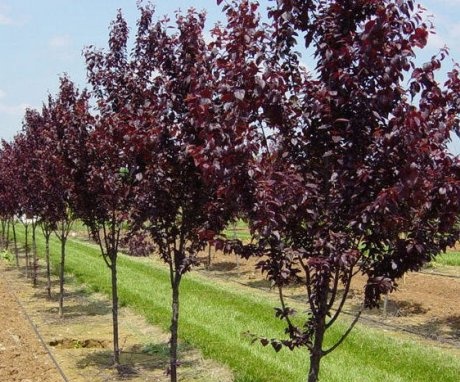Red-leaved plum: species, varieties, cultivation
Most varieties drain appreciated for tasty and healthy fruits. But there are species that are also used to decorate the garden. These are varieties that are distinguished by bright flowering or unusual red-violet color of the leaves.
Content:
Red-leaved plum varieties
Among the red-leaved varieties of plums, there are:
- Spread out.
- Russian plum.
- Hollywood is a mid-early ripening table variety.
The red-leaved plum adorns any area where it is planted. But placing a large number of such trees nearby is not worth it. Usually one tall tree with red leaves is planted on the site.
Their dark leaves beautifully set off trees with light green (Apple tree, willow, sycamore), or silvery (sea buckthorn, goof) leaves. Looks good against the background of evergreen conifers. In the case of planting dwarf plums, you can form a hedge from them.
Spreading plum
The spreading plum is a tall tree with fast fruiting. The first fruits appear already in the second year of life. In wild varieties they are small and sour, in cultivated varieties they are larger, up to 60 g. About 40 kg of plums can be obtained from one tree. The crown is spreading.
The spreading plums include varieties with red leaves, including:
- Pissardi. Red-leaved plum Pissardi, or red-leaved cherry plum, originally from Iran. The tree grows up to 6 m in height. It has red shoots and dark purple leaves. They become so in the spring, after budding, they remain the same until autumn. Before the leaves, flower buds bloom. Pissardi plum flowers are large, pink in color. Plum bears fruit abundantly, sour fruits ripen in August. If not removed, they can hang from the branches until fall. At this time, the leaves turn bright red. Average frost resistance. A tree in the southern regions can live up to a hundred years. It is almost not damaged by diseases, only aphids are afraid of pests. The Pissard plum is widespread in the Black Sea region, where it is used for landscaping. It tolerates drought well, can grow on any soil. It is not possible to grow in regions with frosty winters, the plants freeze out.
- Hessei. Plum spreading red-leaved Hessei of short stature. This is a shrub form. It is appreciated for its beautiful leaves of an original color. Immediately after blooming, they are green, as they develop, they acquire a purple color. An uneven border of pink or cream color forms on the leaves. At the end of April, the Hessey plum blooms with white flowers. Blooms for about 2 weeks. The variety is affected by fungal diseases such as perforated and black spot. Has low frost resistance. I cover young plants for the winter. The spreading plum multiplies, like all trees, inoculation, budding and green cuttings.
- Cisten. Dwarf plum Cistena obtained by crossing the Pissardi plum and sand cherry... It grows up to 2 m, each year increasing only one and a half centimeters. This is a shrub with a columnar crown shape. Leaves are serrated, shiny, glossy, ovoid. Above they are red-violet, below - dark purple. The flowers are white with a red center. The fruits are purple. Plum is used to form hedge... Plum tolerates pruning, which allows you to create bushes of various shapes. Leaves adhere tightly to the branches until late autumn. Young shoots can freeze under severe frosts in winter. In the spring they are cut off, and the bush does not lose its decorative effect. By crossing the Pissardi plum with American and Chinese species of this plant, scientists have obtained varieties with red leaves that are resistant to frost.
Not only the leaves, but also the young shoots of the plum are red. The younger they are, the brighter their colors. Over time, the shoots turn brown.
Russian plum
Russian plum or red-leaved cherry plum obtained from crossing the thermophilic cherry plum with frost-resistant varieties of plums. When creating hybrids, Ussuri and Chinese plums were used.
As a result, varieties were obtained, bearing the name Russian plum. These include:
- Early. Plum red-leaved Early reaches a height of 7 m. The crown is rounded, the leaves with a serrate edge are oblong, about 6 cm long. From above they have a brown tint, from below they are red. Propagated by grafting, budding and green cuttings.
- Scarlet Sails. Russian plum Alye Parusa blooms with dark pink flowers. This is a mid-late variety. The fruits ripen in mid-August. They are small, each weighing about 25 g. The color is dark crimson. The pulp is red, juicy, aromatic, sweet and sour taste.
- Lama. Plum Lama is a semi-dwarf hybrid bred for cultivation in the north of the middle lane. It is successfully grown in the Khabarovsk Territory and the Far East. The tree can withstand frosts down to -35 ° C in winter, and flowers and leaves can survive for a short time when the temperature drops to -7 ° C. The height of the tree is 1.3-2 m. The crown is flat-round. Shoots grow actively, thickening the crown. Therefore, formative pruning should be carried out periodically. Crossed and growing shoots inside the crown are removed. You can not peel them off on the ring, but leave twigs 7-10 cm long. Flower buds will form on them next year. Carry out green pruning for the same principle. It is better than the spring one because the wounds heal faster without harming the tree.
Hybrids are not afraid of winter frosts. Therefore, they can be grown in the middle lane. The varieties combine the advantages of cherry plum and plum:
- They are practically not affected by diseases and pests, aggressive natural factors.
- The taste of the fruit is much better than that of cherry plum.
- They bear fruit steadily.
- They give a high yield.
- They are not afraid of drought.
- They grow on any soil.
Plum Hollywood
Hollywood plum with rounded fruits is a winter-hardy variety of medium ripening. The pulp is yellow, tender, juicy, fragrant, the skin is thin, marbled, easily removed from the fruit. Weight 35 g. A tree of medium height, with a sparse drooping crown.
Shoots are straight, the number of leaves on them is small. The leaves are red, on a long thin petiole. The flowers are double, the petals are white. A high-yielding table variety that can be used as an ornamental variety.
Growing red-leaved plum
It is difficult to formulate general growing conditions for such different varieties. But they differ mainly in frost resistance. The area for the red-leaved plum must be taken with a neutral acidity... The growing nettle, chamomile, coltsfoot. It is better to cover the site with clover, bluegrass, field grass. Fruits, falling from the tree, will not break. Weeds will not grow in this area. The depth of the groundwater is one and a half meters.
It is better to take seedlings with an open root system.
So you can immediately see the possible shortcomings of the root: thickening, deformation, unevenness or injury. When buying seedlings with a closed root system, look at the drainage hole. Young roots should look out of it. If they are not there, it is dangerous to take such a tree.
Buy one-year or two-year-old seedlings with an open root system in the fall. They are transported wrapped in a damp cloth and placed in polyethylene.In the southern regions they are planted in the fall, in the northern ones they are added at an angle for storage until spring. Potted seedlings can be purchased and planted in May and early June.
Features of planting a seedling:
- In the fall or a couple of weeks before planting, pits are prepared with a depth of 60 cm and a radius of 50 cm. The removed earth, 0.5 kg of superphosphate, 2-3 buckets of humus are mixed. Fill the prepared hole to half the height. It sags until the moment the seedling is planted. If this is not done, the soil will sag after planting, pulling the roots of the plant along with it and cutting them off.
- Prepare the seedling just before planting. They soak it in a clay mash, to which 2 tablets of the root former Heteroauxin were added.
- Place the seedling in the hole, straighten the roots. In the southern regions, the root collar is set at the level of the pit, in the northern regions it deepens by 3 cm.This will allow the tree to grow after possible freezing.
- A peg for tying is placed next to the tree. Sprinkle the remaining soil on the root system. Watered, compacted. Tie the plant with a string to a peg. It will hold the plum for the first years until the trunk gets stronger.
- Pruning is carried out by shortening the branches by a third. This will cause the side shoots to grow.
- Mulch a trunk circle to retain moisture in the root system. Humus, cut grass or even dry soil 10 cm thick are used as mulch.
More information can be found in the video:




